As the school-choice movement accelerates across the country, several major cities—including Cincinnati, Detroit, Memphis, Milwaukee, and Washington, D.C.—are expanding their charter-school portfolios. Historically, communities have used charter schools not only in hopes of spurring traditional schools to improve but also to increase the variety of options available to families. If family preferences vary, and schools are given the autonomy to innovate and respond to market pressures, the theory holds, then we should expect a rich variety of schools to emerge.
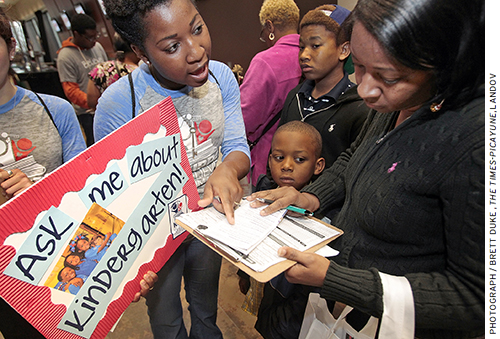
But does this theory hold up in practice? First, it is not clear that parents do have distinct preferences when shopping for schools. If parents are uncertain about their child’s skills, they may play it safe and seek out a generic “basket” of school services. Second, charter schools always face the possibility of closure for low performance, and this threat may pressure the schools to avoid risk by imitating successful charter models. Government regulations might also inhibit a school’s capacity to offer a unique program. And finally, large charter management organizations (CMOs) may attempt to leverage economies of scale by replicating a single model at multiple schools. Conceivably, the market strategies of charter schools and large CMOs, rather than the needs of families and students, could drive the market, leading to more imitation and less diversity.
The city of New Orleans offers an ideal laboratory for examining how much true “choice” resides in a public school market. With 93 percent of its public-school students attending charter schools, New Orleans has the largest share of students enrolled in charters of any U.S. city. In some ways, the New Orleans system is unique, having been launched in the wake of a terrible disaster. However, the city’s student population—majority minority and mostly eligible for lunch subsidies—is typical of other urban centers where school reform is growing. Furthermore, the CMOs in New Orleans are supported by many of the same national foundations that support charter schools across the U.S., suggesting that similar patterns might emerge in other expanding charter markets. This study examines public schools in the Big Easy, investigating how—and how much—schools have differentiated themselves in a citywide school-choice system.
A New Approach
Previous studies have focused on the differences between charter schools and district schools, treating all charters within a community as essentially alike. In effect, these studies take a “top-down” approach, assuming that the governance of the school (charter versus district) determines the nature of the school. This approach may be appropriate where charter schools are few and their role is to fill service gaps. By contrast, our study adds a “bottom-up” approach, focusing not on governance but on salient school characteristics such as instructional hours, academic orientation, grade span, and extracurricular activities—factors that determine what students and families actually experience.

We ask, are New Orleans schools homogeneous or varied? Is this answer different when we use the bottom-up approach based on school characteristics rather than the top-down analysis based on school governance? And finally, to what degree is the New Orleans school market composed of unique schools, multiple small segments of similar schools, and larger segments of similar schools?
Grouping schools by key characteristics, we find considerable differentiation among schools in New Orleans. Furthermore, schools operated by the same CMO or governed by the same agency are not necessarily similar to one another. In fact, the differences and similarities among schools appear to be somewhat independent of what organizations and agencies are in charge. Overall, we find that the market comprises a combination of large segments of similar schools and smaller segments of like institutions, but also some schools that are truly unique.
A Charter School “Laboratory”
In 2003, the Louisiana Department of Education (DOE) created the state-run Recovery School District (RSD) and empowered it to take over failing schools. At the time, only a handful of charter schools were operating in New Orleans. In the aftermath of Hurricane Katrina in 2005, city and state leaders used the RSD to take over all underperforming schools in the city. The local school board continued to manage a small number of high-performing schools, some of which have selective admissions.
Over the next several years, the RSD contracted out the schools under its control to CMOs, including both single-school operators and larger CMO networks. Policymakers also expanded school choice by eliminating geographic attendance zones for students: students were henceforth free to enter lotteries for any open-enrollment school in the city. Open-enrollment schools in New Orleans, as well as some selective-admissions schools, provide free transportation to students across the city.
The city’s charter schools are governed by three different agencies: the state’s Board of Elementary and Secondary Education (BESE), the RSD, and the Orleans Parish School Board (OPSB). The schools are managed by more than 30 school operators. This milieu creates the potential for a wide variety of schools to emerge in New Orleans. But as noted, regulations and accountability demands could stifle diversity. For example, the RSD and DOE have strict test-based requirements for charter contract renewal; 45 schools have been closed, merged, or turned over to other operators since 2007. Also, state regulations set restrictions in some areas but provide autonomy in others. For instance, DOE establishes standards for teacher preparation and certification, but charter schools are allowed to hire uncertified teachers. All schools, including charters, are required to participate in the statewide teacher-evaluation system. The net effects of these policies on school autonomy and differentiation are unclear.
Data
Our study focuses on the 2014–15 school year; by that time, 100 percent of the RSD schools were operated by CMOs (including the schools formerly run directly by the RSD). The OPSB continued to operate a small number of district schools and was expanding its own charter-school portfolio. A final small group of charter schools continued under direct supervision of the BESE.
Our data come from the spring 2014 edition of the New Orleans Parents’ Guide to Public Schools, published annually by a local nonprofit organization and distributed free of charge. This publication is the primary formal source of information for parents choosing schools in New Orleans.
From the guide, we selected eight characteristics that reflect decisions schools make when designing their programs:
· whether the school has selective admissions or open enrollment
· whether the school mission is “college prep”
· whether the school has a specific curricular theme (e.g., math, technology, or arts)
· number of school hours (annual total)
· number of grades served
· number of sports
· number of other extracurricular activities (“extras”)
· number of student support staff (nurses, therapists, social workers, etc.).
We also considered measures that are not in the Parents’ Guide. For example, we ran some analyses with the number of suspensions and expulsions, as an indicator of discipline policies. This did not change the clustering. For other categories, such as instructional approach, we did not have good measures.
Note that not all New Orleans schools have autonomy over their admissions policies. Selective admission is permitted at OPSB district and charter schools and at BESE charter schools, but not at RSD schools. Any school can attract or repel certain student populations through the menu of enhanced student-support services that it offers, however. For example, schools with an on-site speech therapist might be more attractive to parents of children with individualized education plans (IEPs) requiring these services. Our measure of the intensity of student support services may therefore help to identify open enrollment schools that target a distinct student population.
Methods

The simplest version of the top-down theory predicts that the number of differentiated “clusters” in a public school market will correspond to the number of governing agencies. New Orleans has two authorizers: the OPSB and BESE. Both authorizers are also the governing agency for some of their schools. BESE also authorizes the schools governed by the RSD, which are low-performing schools taken over by the state. If these three governing agencies have singular “tastes” for certain kinds of schools, we should observe high similarity among schools that fall under the same agency, and differences across governing agencies. To see the extent to which schools differ across the three governing agencies, we first group the schools by governing agency and check for differences along the characteristics listed earlier.
Next, we expand the top-down groupings to allow for additional differences between district-run schools, independent charter schools, and charter network schools (run by a CMO that operates multiple schools). This creates five groups of schools in New Orleans:
· OPSB district schools
· OPSB charter schools
· RSD charter network schools
· RSD independent charter schools
· BESE charter schools.
We then compare the results of this exercise to those obtained when we ignore governance arrangements and instead group schools from the bottom up, based on their characteristics alone. To do this we use cluster analysis, a statistical method designed to group objects of study (in this case, schools) based on similar qualities.
With cluster analysis, we can specify the number of groups that will be formed. To start, we first allow schools to form either three or five clusters to test whether similar governance predicts membership in the same cluster.
We then allow schools to form more clusters (up to 10) and select the best grouping based on meaningful within-group similarities and across-group differences. This strategy tests for the possibility of market segments that are not described in the top-down theory and allows us to identify schools with unique combinations of the measured characteristics (niche schools).
Results
We focus separately on 56 elementary schools and 22 high schools included in the Parents’ Guide. New Orleans school operators can select each school’s grade span, and it is quite common for elementary schools to serve grades K–8 and uncommon to have schools with just middle school grades (5–8). Therefore, we define elementary schools as those with any grade K–4, and high schools as those with any grade 9–12. A small number of schools that serve only middle-school grades were not included in this study.
On average, elementary schools enroll 540 students; 86 percent of students are eligible for free or reduced-price lunch, and 87 percent are black. Ninety-five percent of elementary schools are charter schools, 50 percent have a college-prep mission, 43 percent have a specific curricular theme, and 9 percent use selective admissions. For high schools, average enrollment is 550 students, with 78 percent of students eligible for free or reduced-price lunch; 84 percent of students are black. Ninety-six percent of high schools are charter schools, 52 percent have a college-prep mission, 57 percent have a specific curricular theme, and 22 percent use selective admissions.
Grouping from the Top Down: Elementary Schools. When we examine school characteristics by governing agency alone (three groups), we find that the groups differ by a statistically significant amount on only one of the five continuous variables we examine. Specifically, schools governed by the RSD have more school hours. When we analyze school characteristics by governing agency and school type (five groups), we find no statistically significant differences on these same variables. We do observe some modest differences across groups in the average values of the three yes/no variables (open enrollment or selective admissions, curricular theme or not, and college prep or not). Overall, however, results from the top-down approach suggest that governance arrangements do not correlate with notable differences in school characteristics.
High Schools. When we group the 22 high schools by governing agency (three groups) and by governing agency and school type (five groups), we find in both cases that the clusters differ on the number of sports offered. In the three-group structure, clusters also differ on the number of student support staff, while in the five-group structure, they differ on grade span.
Grouping from the Bottom Up: Elementary Schools. Despite modest differences between elementary schools grouped by governing agency and school type, we find that no two individual schools are identical on all eight variables. The two schools that are most similar to one another overall are a pair that includes an OPSB district school and an RSD charter network school. The second most similar pair includes an RSD charter network school and an OPSB charter school. These groupings provide initial evidence that the most similar schools across all characteristics do not share the same governing agency and type.
We first cluster the schools into three groups to further test the top-down assumption that school characteristics will be roughly aligned with the governing agency—the OPSB, the RSD, or BESE. In other words, we let the data determine the school groupings that produce the highest degree of similarity within groups and see whether the schools within those groups tend to have the same governance arrangement.
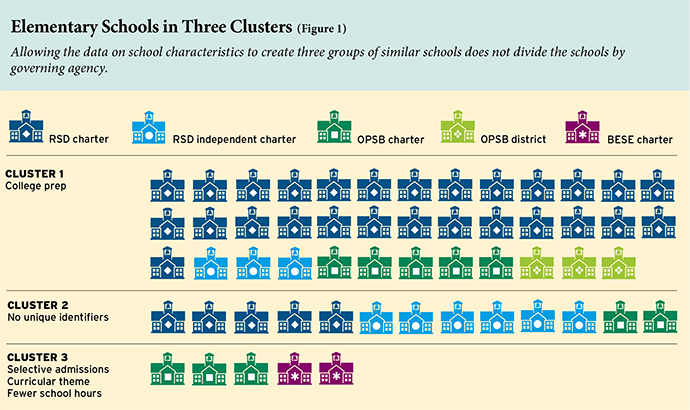
Figure 1 shows that schools can exhibit similar characteristics but not share a governing agency. For example, cluster 1 is composed of schools that share a college-preparatory mission but represent two of three governing agencies, although most (28 of 38) are RSD charter network schools. Thirteen schools that share enough similarities to form a second cluster also include RSD and OPSB schools, but most are RSD independent charter schools. The third cluster of five schools includes three OPSB and two BESE charters that have selective admissions and a specific curricular theme.
Statistical analysis suggests there are no meaningful differences described by this grouping other than the differences in admissions, theme, and mission mentioned above. Overall, these results suggest that the RSD governs schools that are more similar to one another than those governed by the OPSB. But we are able to reject the hypothesis of the top-down theory that the governing agency predicts either similarities within school groups or differences across school groups; we also find evidence of differentiation within school operators.
We next test five groupings and again find that schools do not cluster by the combination of governing agency and school type (results not shown). The first cluster includes 19 schools, all but two of which are RSD charter network schools. However, RSD charter network schools are also found in three of the other four clusters. The other governing agency-school type combinations also appear in multiple clusters, except for the two selective-admissions BESE charter schools that form a cluster with three selective-admissions OPSB charters. Six of nine RSD independent charter schools are grouped in one cluster, but that cluster also contains RSD charter network schools and OPSB charter schools. OPSB charter schools appear in four of the five clusters.
Interestingly, even the CMO does not frequently predict cluster membership. While some larger CMOs have all their schools in a single cluster, KIPP, ReNEW, Algiers Charter School Association, and other charter networks have schools in multiple clusters.
Finally, the three OPSB district elementary schools, which might be expected to be the most similar because they are the only New Orleans schools operated by a government bureaucracy, also appear in multiple clusters. OPSB district schools are clustered with schools with several other governance arrangements, including RSD charter network schools and RSD independent charter schools.
Next we examine how the five clusters differ on the five continuous variables. The groups are not statistically different in extracurricular activities, sports, student support staff, or grade span. The groups do vary across school hours, with the two clusters composed of college-prep elementary schools reporting more hours than other clusters. Clustering to five groups explains only 38 percent of total variance in continuous clustering variables.
Overall, these results suggest that grouping schools by governing agency and type does not capture the market structure in New Orleans. Although we observe that RSD-governed schools tend to cluster together, there are multiple governance-type combinations represented in each cluster, and a CMO can have schools in up to three different clusters. Thus, the top-down theory of three or five groups appears to be inadequate to identify meaningful differences across schools.
We next characterize the market by allowing the clusters to emerge from the data. When we allow 10 groups to form, we find that the groups are statistically different along all continuous clustering variables, except the number of student support staff (see Figure 2).
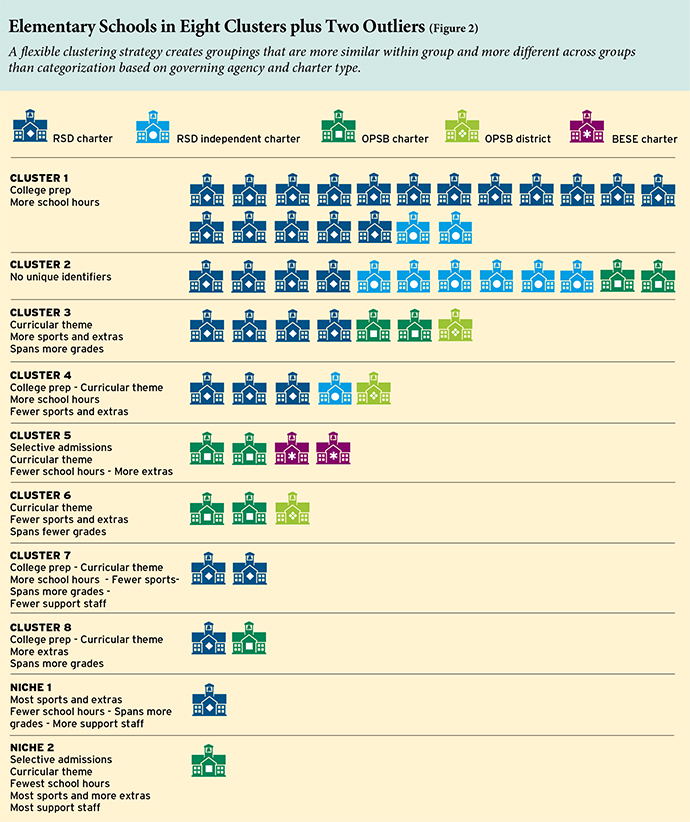
Cluster 1 contains 19 RSD charter schools with more-than-average school hours and a college-prep mission. Cluster 2 contains two OPSB charter schools and 10 RSD charter schools. The schools in this second cluster have near-average values for all continuous variables, and they do not have a curricular theme or college-prep mission.
Six other clusters capture additional nuance in the supply of schools. All the schools in these six clusters have at least one school with a curricular theme, and three of the six clusters contain only schools that also have a college-prep mission. However, the clusters vary across all the continuous variables except student support staff.
Finally, two elementary schools appear as outliers in the analysis, suggesting they occupy niches in the market. The first is a selective-admissions OPSB charter school with a curricular theme, fewer school hours, more extracurricular activities and sports, and a large grade span. The second is an RSD charter school with no curricular theme or college-prep mission, but higher than average numbers of extracurriculars, sports, and student support staff.
Overall, this more-flexible clustering strategy creates groupings that are more similar within group and more different across groups than clustering based on governing agency and school type. We observe that a single CMO can manage schools that differ from each other, and that similar schools can be governed by different agencies and managed by different organizations. We find that RSD schools are more likely to cluster together than are OPSB schools, which often occupy smaller market segments. Finally, we see that elementary schools cluster in groups with varied levels of school characteristics—except for student support staff. We find little evidence that any New Orleans elementary schools differentiate themselves by offering more in-house support staff than other schools.
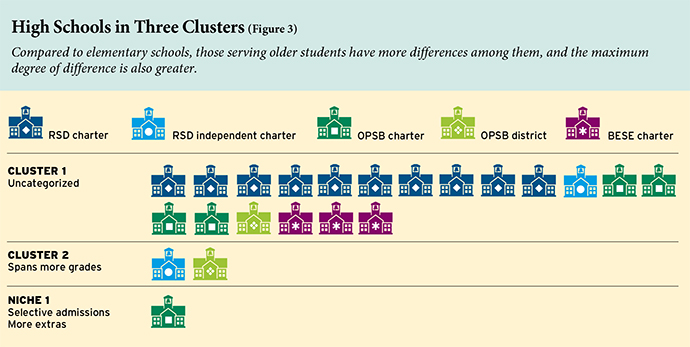
High Schools. The 22 New Orleans high schools include 12 RSD, 7 OPSB, and 3 BESE schools. There are 10 RSD charter network high schools, 2 RSD independent charter high schools, 5 OPSB charter high schools, 2 OPSB district high schools, and 3 BESE charter high schools. These groups vary statistically in the number of sports offered and student support staff, and also grade span.
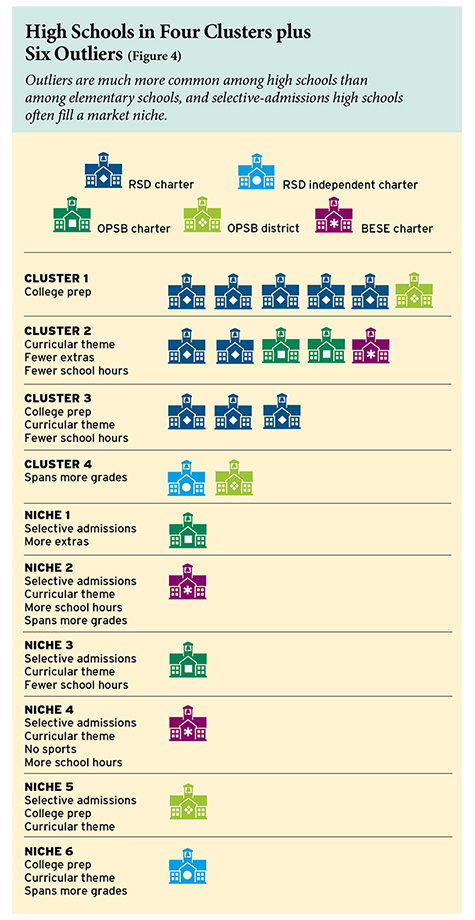 First, we use the school characteristics data to form three clusters. Compared to elementary schools, high schools appear to have more differences among them, and the maximum degree of difference is also greater. Overall, these findings do not support the assertion that schools vary by governing agency (see Figure 3). Re-clustering into five groups also did not create groupings that reflect the combination of governing agency and school type (results not shown).
First, we use the school characteristics data to form three clusters. Compared to elementary schools, high schools appear to have more differences among them, and the maximum degree of difference is also greater. Overall, these findings do not support the assertion that schools vary by governing agency (see Figure 3). Re-clustering into five groups also did not create groupings that reflect the combination of governing agency and school type (results not shown).
Using the flexible clustering strategy, we see a mixture of governing agency and school type across four clusters, with six outliers (see Figure 4). The largest cluster includes six high schools—one OPSB school and five RSD charter network schools run by four different CMOs. The second cluster is also diverse, with five total schools from three governing agency and type combinations. We also observe charter network schools and the OPSB schools in different clusters. The six outlier high schools include one OPSB district school, two OPSB charters, two BESE charters, and one RSD independent charter school.
Five of the six niche schools are selective-admissions schools. Five of them have a curricular theme (such as science and math, intercultural studies, or performing arts), and two have a college-prep mission. Outliers tend to have more extracurricular activities, shorter school hours, and larger grade spans. Overall, outliers are much more common among high schools, and every selective-admissions high school has its own niche.
Conclusion
New Orleans presents the opportunity to study an urban school system where charter schools comprise more than 90 percent of school campuses and total student enrollment. We find that school characteristics vary within both governance arrangements and individual CMOs, and that the most similar schools are often governed by different agencies and have different managing organizations. We also found a greater degree of market differentiation than would be expected from a top-down approach. Our methods reveal 10 distinct types of elementary schools comprising large segments of similar schools, small segments of two to three schools, and niche schools. Among high schools, we found four segments (both large and small) and a larger number of niche schools. This may reflect more specialized interests among older students.
Charter schools governed by the RSD are often, but not always, similar to each other, with emphasis on college-prep missions and more school hours. It is unclear if this reflects governing agency preferences or the fact that RSD schools are, by definition, previously low performing and therefore may be more constrained by test-based accountability. Moreover, schools within the same CMO network are often, but not always, similar to each other. Amid this similarity, we also find that within the RSD, CMOs can and do create diversified portfolios of schools.
Schools outside of the RSD are more likely to be diverse. For example, OPSB charter schools differ considerably from each other and often serve a market niche. Particularly at the high-school level, charter schools governed by the OPSB or BESE create niche markets with a curricular theme, while different CMOs come together to form a segment of similar schools, often sharing a college-prep mission. In the New Orleans context, this suggests that governing agencies may be more willing to provide unique offerings when they manage higher-performing schools with little risk of sanctions related to standardized testing. Furthermore, uniqueness often comes with selective admissions, which suggests that access to diverse school choices is greater for students who through ability or parent involvement can navigate a complex system of admissions rules and testing.
The small number of schools that remain under the bureaucratic control of the OPSB play a notable role in the school market. These schools appear in smaller clusters or stand alone as different from most charter schools. They also do not typically cluster with one another, suggesting that even a bureaucratic system can offer diverse options in a school-choice system.
Our study indicates that New Orleans parents can choose from among schools that vary on several key dimensions, and that these differences are not necessarily driven by the decisions of charter governing agencies or large CMOs. Even within large CMOs, we found significant variation among schools; for example, the expansion of KIPP in New Orleans to manage five elementary campuses did not result in five schools with identical characteristics.
Finally, we note that much of the market differentiation in New Orleans comes from schools authorized or run by either the Orleans Parish School Board or the Board of Elementary and Secondary Education. Having multiple governing agencies may be important for market differentiation.
As more cities expand school choice, we will have the opportunity to compare New Orleans to other markets to see how factors such as economies of scale, regulations, and demand influence the amount and quality of differentiation. We will also be able to observe the evolution of public school markets over time, to see if competitive pressures result in more differentiation or a drift toward imitation—and how such trends affect student outcomes.
Paula Arce-Trigatti is postdoctoral fellow in economics at Tulane University and the Education Research Alliance for New Orleans. Douglas N. Harris is professor of economics at Tulane University and founder and director of ERA-New Orleans. Huriya Jabbar is assistant professor of education policy at the University of Texas at Austin and research associate at ERA-New Orleans. Jane Arnold Lincove is assistant research professor of economics at Tulane University and associate director of ERA-New Orleans.
For more information on New Orleans, read “Good News for New Orleans: Early evidence shows reforms lifting student achievement,” by Douglas N. Harris, and “The New Orleans OneApp: Centralized enrollment matches students and schools of choice,” by Douglas N. Harris, Jon Valant, and Betheny Gross.
This article appeared in the Fall 2015 issue of Education Next. Suggested citation format:
Arce-Trigatti, P., Harris, D.N., Jabbar, H., and Lincove, J.A. (2015). Many Options in New Orleans Choice System: School characteristics vary wildly. Education Next, 15(4), 25-33.


